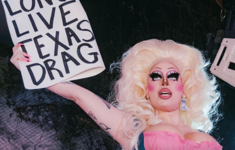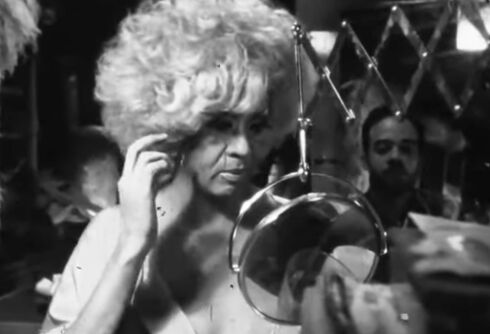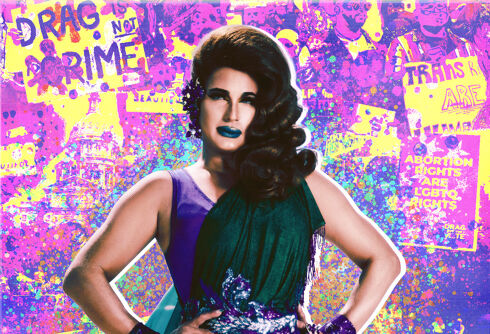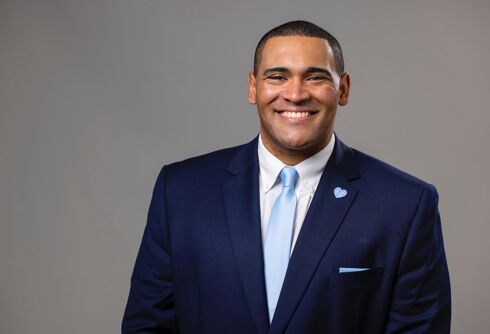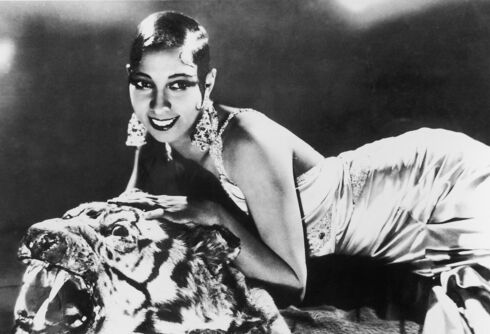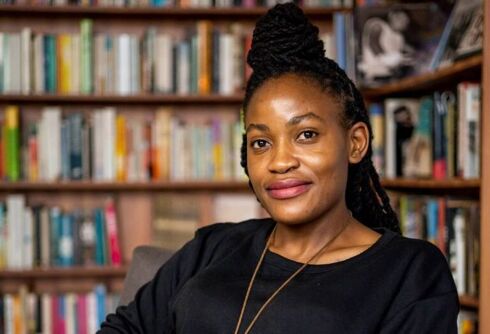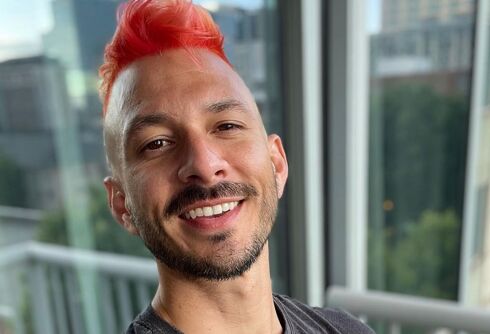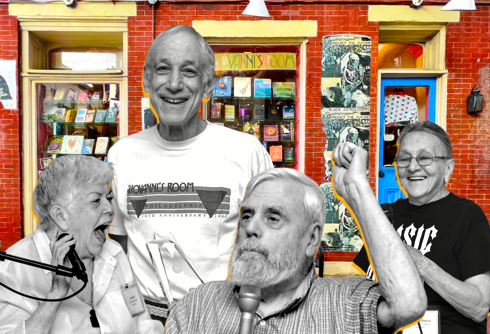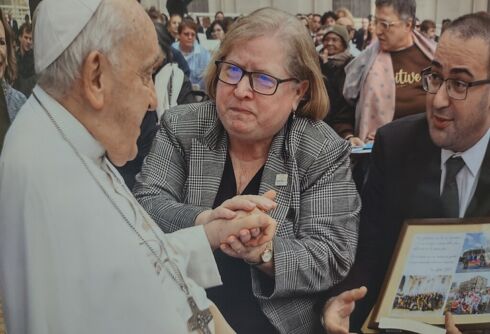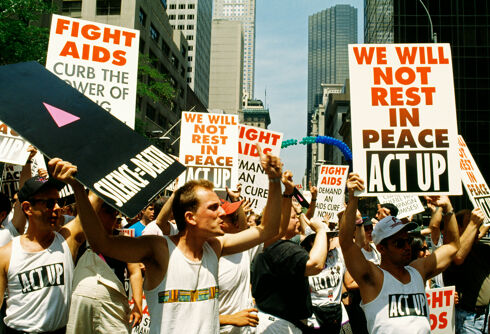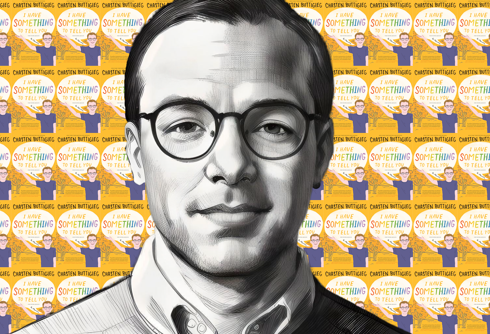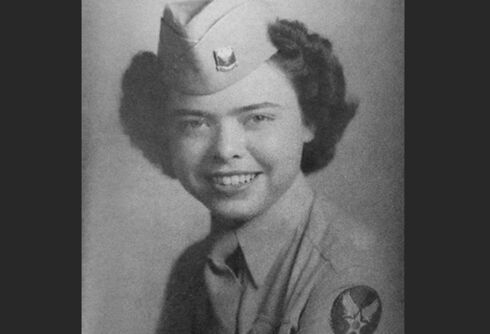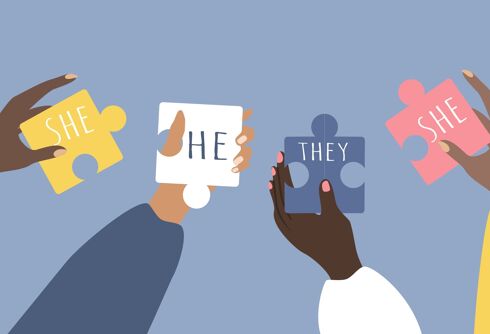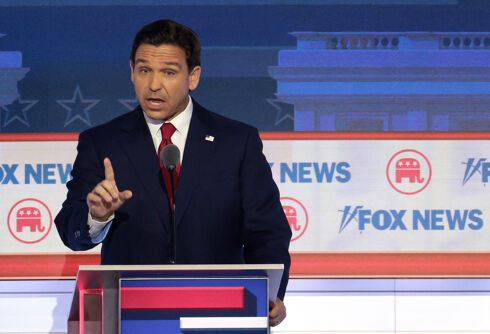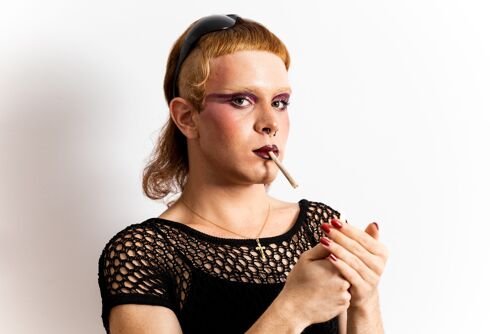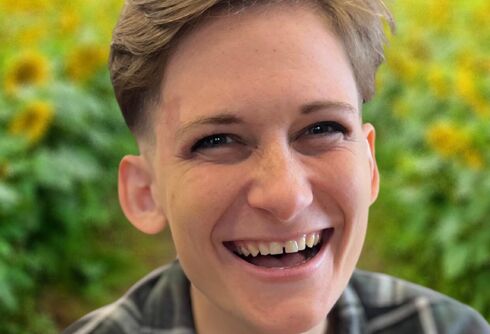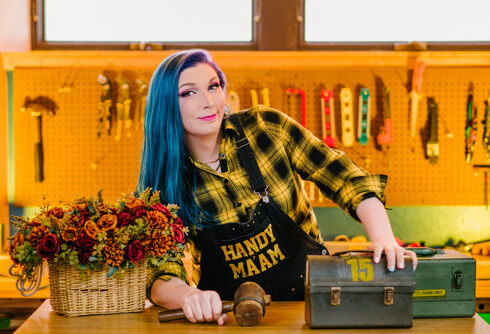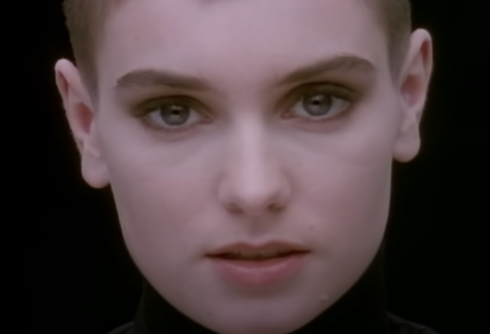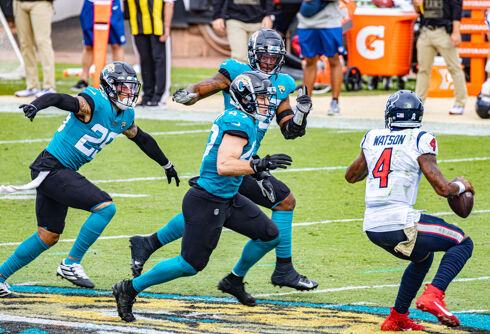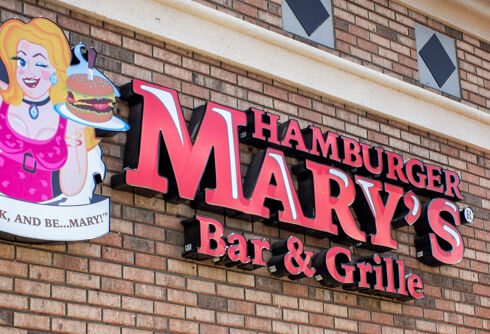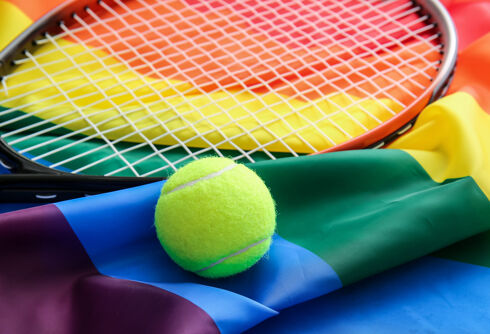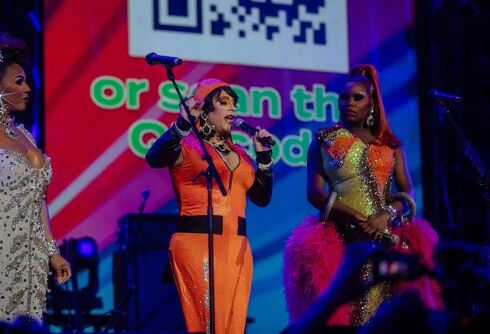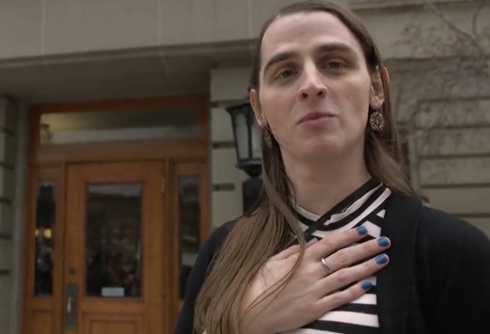On a recent Wednesday night, writer and photographer Elyssa Maxx Goodman was in Brooklyn to see a drag show. It was not a particularly convenient drag show. The venue, Brooklyn’s C’mon Everybody, was at least a three-train subway ride from Goodman’s apartment. But the author of the recently published Glitter and Concrete: A Cultural History of Drag in New York City is the sort of woman who will go to those lengths to see performers that she loves.
“Mthr Trsa and Brenda are geniuses,” she said of the show’s hosts and stars. “To me, their humor is very reflective of the Pyramid Club. Very self-aware, cultural criticism through the guise of silliness. And it’s so intelligent and funny. If there’s a Britney mega mix — and I don’t think there will be — it will be extremely ironic and it will be wonderful. It’s sort of that approach to the cultural machine.”
Related:
Federal judge strikes down Texas drag ban
“This decision is a much needed reminder that queer Texans belong and we deserve to be heard by our lawmakers.”
Goodman takes drag’s silliness seriously — the Britney mega mixes, the outré Brooklyn performance art, and everything in between—and she has from a young age. Her devotion to the art form goes all the way back to childhood, when she first saw the comedy To Wong Foo, Thanks for Everything! Julie Newmar and became obsessed with the glittering costumes and over-the-top makeup. It reminded her of the classic movie musicals she watched with her mother.
Never Miss a Beat
Subscribe to our newsletter to stay ahead of the latest LGBTQ+ political news and insights.
“Pretty much any way that I could consume drag after that, I did,” she said. “My parents were really supportive. They were like, ‘Watch The Birdcage with us.’ As I got older, I was going to the movies to see Connie and Carla with my friends and educating myself watching Paris Is Burning. Any format that I could interact with drag, I wanted to.”
In Glitter and Concrete, a nearly 400-page examination of the history of New York’s drag scene stretching from the mid-19th century up to the present moment, Goodman writes that she wanted to create the sort of book she would want to read. She also hopes that the book will be a source for contemporary drag fans raised on RuPaul’s Drag Race to discover “how the art form got to the place it currently occupies.”
Of course, the place drag currently occupies in American culture is an interesting one. It is perhaps more mainstream than it has ever been, thanks in large part to the success of Drag Race. At the same time, it has recently become a target of attacks from newly emboldened anti-LGBTQ+ conservatives. Goodman is certainly aware of the cultural context into which Glitter and Concrete is being released, and that’s where her conversation with LGBTQ Nation began.
LGBTQ Nation: We’re in a moment of wild backlash against LGBTQ+ rights and visibility, and a lot of it has centered on drag and whether parents should allow their kids to see it. So it was really interesting to read about how enthusiastic your parents have always been about your interest in drag.
Elyssa Maxx Goodman: I started writing about drag almost 12 years ago, and at that time one of the articles I was writing was about my relationship to To Wong Foo… And I interviewed my mother and I said, ‘Why did you let me watch this?’ And she said, ‘It was a costume and it was fabulous! What else was there to know?’ It’s a mode of expression the way that any other mode of style or any other art form is. And that’s what it was to them. Because that’s what it is!
LGBTQ Nation: You write in the book that you want contemporary drag fans to understand how the art form got to where it is today. First, how would you characterize drag’s contemporary fanbase?
EMG: I think a lot of the modern mainstream audience relationship to drag starts with RuPaul’s Drag Race. But I quote Trixie Mattel in the book — and often just in my life — and she says, ‘Saying you love drag but you only watch RuPaul’s Drag Race is like saying you love music but you only watch American Idol.’ And that’s sort of the roots for the book as well. Yes, love this art form, but also, know where it comes from.

LGBTQ Nation: Do you have the sense that a lot of contemporary drag fans don’t have an appreciation for that?
EMG: I don’t want to make a generalization about a very large and diverse audience. But I know that there’s not usually an outlet for people to receive drag history, and I wanted there to be one. Because [Drag Race] can only do so much. So, to have another space where you can learn about all the people who came before this moment was something I wanted to do.
LGBTQ Nation: To your point, drag has for so much of its history been an underground art form. I imagine that made it challenging to research the history of drag in New York. How did you approach researching the book?
EMG: When I first proposed the book, it started in 1945. And then as I kept researching to sort of provide an introduction, it just kept going and going and going and going. And that shouldn’t be a surprise, because drag is an art form that is thousands of years old. So, the challenge became assembling a massive history.
LGBTQ Nation: Was it difficult to find some of these stories? To find records of these performers and shows and venues?
EMG: Some of them. Some of them had been covered by other historians and I was able to dig into that on my own and find my own way into those. And some of them I found, which I was really excited about. Like Andrew Tribble I had never heard about before and I had never read about before, and I was excited to include him in the book. It becomes a longing to tell other people about [these stories], which is sort of how I approach writing about queer history from the beginning. I want you to know about this. I need you to know about this.
LGBTQ Nation: Why did you decide to focus specifically on New York’s drag history?
EMG: New York is my muse! I’m not from New York originally, but my parents were from New York, and there was always part of me that was just itching to be here. When I was first learning about drag, it was about drag that was coming from New York. To Wong Foo… is set in New York. Paris Is Burning is set in New York. And then, digging into each of those, the first things you learn about are the Pyramid Club — or at least that I learned about. Venues like that, and New York is the city that I knew best and there’s so much that comes from this city that shapes the drag that we have now. There’s vibrant drag history in cities all across the country. Houston, Atlanta, L.A., Chicago, Miami. But this is the place that I knew the drag history best.
LGBTQ Nation: How would you characterize New York drag now?
EMG: I would say it’s really multifaceted. I think that wasn’t always the case, historically. Up until probably the 70s, drag looked one way — because it had to due to a lot of respectability politics. And the way that drag was able to exist had to do with the fact that the places where it showed marketed it to straight audiences. So, it had to be, like, long luscious gowns and everything was perfection and chic, and you felt a little naughty taking it in, but it was still ok because everyone was really glamorous. And as the 70s roll around after the Stonewall uprising, there becomes more room for another faction of drag to develop and continue into the 80s and 90s and to now.
What’s interesting is that, I think in drag in general — and this is reflected in New York — I compare it a lot to the birth of rock ‘n’ roll. When rock ‘n’ roll first existed, there was rock ‘n’ roll. And now we have all these different subgenres. What a world to live in where we have such a thing as mainstream drag! I remember when I first moved to New York, I had to explain to people— straight white men — who RuPaul was! And I don’t have to do that anymore.

LGBTQ Nation: It’s so interesting, the idea that there was a time when drag was marketed to straight audiences, and now it almost feels like it’s come full circle in that Drag Race has a huge cis straight female audience. Why do you think so many young women are drawn to drag?
EMG: I don’t know. I don’t want to speak for everyone. I know what drew me to it as that person. I am a boring heterosexual. I mean, I’m not boring. But I knew what drew me to it: it was glamorous and sassy and it was beautiful, and that’s the end of the story for me at that age. As I got older, it became so inspiring and wonderous to see, as Justin Vivian Bond says, glamour used as resistance. It’s magical that this art form has persisted over thousands of years when people wanted it to be gone for decades and decades at a time. And people still keep going, because it is an art form. If you are a sculptor and someone tells you not to sculpt, you’re not gonna stop!
What’s interesting too is that it’s glamour however you want to interpret that: as a drag king, as a drag thing — as we say now — as a drag queen, as whatever you want to be and however you want that to exist on the stage and interpret that. It’s magical.
LGBTQ Nation: Have you ever done drag yourself?
EMG: There was a professor at a university where I was speaking recently, and he was like, “Well, how drag-y are you?” I was like, “Well, I’m in drag as a woman constantly.” I think that’s something else; drag has very much affected — and how could it not — the way that I understand gender and the performativity of it. I came here and I beat my face. I don’t look like this when I’m sitting on the couch watching New Girl reruns! But it’s an understanding of what it means to present in the world as this person, and what are the stories that I want to tell about myself?
I host a nonfiction reading series in the East Village, it’s called the Miss Manhattan Non-Fiction Reading Series, and when I am getting ready for that, the face is beat, painted for the back of the house, red lips, cat-eye, heels of some kind, red, hot pink, black, white color palette generally. And to me, that’s drag. I am presenting. It’s theatricality, and that is another part of me in the way that we all have other parts of ourselves. And when I am onstage, that is the part of me that I show to people, and that’s what drag is. Have I ever performed onstage in Lady Bunny drag? No. I don’t claim that label for myself.




